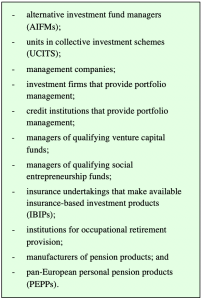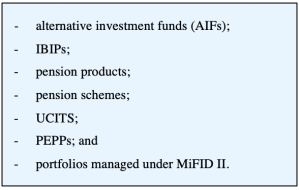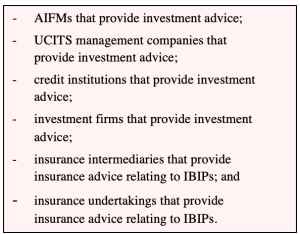Over a year ago, on December 29, 2019, Regulation (EU) 2019/2088 on sustainability-related disclosures for the financial services sector (the “Sustainable Finance Disclosure Regulation”, or “SFDR”) entered into force. Just a few months remain before key provisions begin to apply and asset/fund managers and other financial services firms should not delay in preparing for new disclosure requirements.
The SFDR requires European financial firms to consider how sustainability risks are incorporated into their investment decision-making processes, and the extent to which their financial sector remuneration practices are consistent with sustainability concerns. In short, manufacturers of financial products and financial advisers need to consider and adapt how they operate their business before they can make the disclosures required under the SFDR.
The initiative falls under Action 7 of the European Union’s 2018 Action Plan on sustainable finance, aiming to clarify institutional investors’ and asset managers’ duties in relation to sustainability considerations.
This alert memorandum provides an overview of the SFDR (including as to status, scope and conceptual and technical framework), explores the upcoming regulatory implications of this initiative for European financial sector firms, and provides a comparative analysis of similar regulatory developments in other jurisdictions.[1]
I. In a nutshell
The SFDR stems from the premise that disclosures to end-investors on the integration of sustainability risks, adverse sustainability impacts, sustainable investment objectives, and the promotion of environmental or social characteristics in investment decision‐making and advisory processes are insufficiently developed – in part, because they are not yet subject to harmonised requirements.
On that basis, the SFDR introduces a set of new ESG transparency and disclosure requirements for certain financial services firms – including, in particular, asset managers and fund managers, with respect to:
– website disclosures;
– pre-contractual disclosures (such as fund prospectuses); and
– periodic reporting to investors.
In addition, the SFDR defines the concept of a “sustainable investment”, which requires that investee companies engage in activities that contribute to an environmental or social objective, provided that (a) the investment does not significantly harm (“DNSH”) any such objectives, and that (b) the investee follows good governance practices. Such disclosures are to be prepared with reference to the criteria for determining whether an economic activity can be considered “environmentally sustainable,” as set forth in the Taxonomy Regulation.[2]
Many important aspects of the SFDR will apply to all asset or fund managers, even those that do not have an express ESG-related objective (although some will only apply to financial products with a specific ESG focus).
The extensive disclosure requirements are expected to drive firms to review how sustainability risks are incorporated into their investment decision-making processes and, potentially, make internal strategic changes as to how they operate their business, both for purposes of achieving compliance with the SFDR and (re-)positioning themselves on the financial market. This will in turn require significant engagement with investee companies (as well as with investors or other intermediaries who may themselves be subject to the requirements) and ongoing due diligence and portfolio monitoring.
II. Status
The SFDR entered into force on December 29, 2019. Most of the Regulation’s substantive framework requirements and general principles will, however, apply starting on March 10, 2021. Others (relating mostly to periodic reporting obligations) will apply as from January 1, 2022.
As for the more detailed (so-called, “Level 2”) technical standards (currently being developed by the three European Supervisory Authorities, i.e., ESMA, the EBA and EIOPA), the Commission confirmed in October 2020 that these will no longer become applicable from March 2021 but rather, instead, “at a later date” (likely not until 2022).
III. Scope
The entities that fall within the scope of application of the SFDR are, broadly speaking:
- Financial market participants who manufacture or provide to the market certain “financial products” (i.e., portfolio managers, fund managers, pensions providers); and
- Financial advisers (i.e., providers of investment or insurance advice).
Of the above – financial market participants include:
The financial products administered by financial market participants are:
Financial advisers include:
The territorial scope of the SFDR is somewhat unclear – in particular, the extent to which non-EU AIFMs will be subject to the requirements at the entity level (as opposed to merely the product level).
The UK Financial Markets Law Committee is looking to raise this issue with the EU.
IV. Key provisions
Disclosures to be made under the SFDR include:
- at the entity level : (financial market participants and financial advisers: website disclosures)
-
- a requirement to provide information on their policies on the integration of sustainability risks in their investment decision‐making process or advice;
- a requirement to include in their remuneration policies, and disclose, information on how those policies are consistent with the integration of sustainability risks;
- a comply or explain requirement with respect to consideration and due diligence of principal adverse impacts on sustainability (“PAIs”) of investment decisions and investment advice;
- at the product level :
- a requirement to explain how ESG risks are likely to impact investment returns; (financial market participants and financial advisers: pre-contractual disclosures)
- a comply or explain requirement with respect to PAIs; (for financial market participants and financial advisers: pre-contractual disclosures)
- a requirement to disclose the ESG performance of, all throughout the life of the product,:
- any products which promote environmental or social characteristics (k.a. “Article 8”, or “light-green”); and
- any sustainable investments
(e., products which have sustainability as their outright investment objective – a.k.a. “Article 9”, or “dark-green”); (for financial market participants: pre-contractual disclosures, websites and periodic reports).
V. Technical implementing provisions
In April 2020, the three European Supervisory Authorities (ESAs) launched a joint consultation (ended on September 1, 2020) on the draft regulatory technical standards (“RTSs”) to be issued by the Commission under the SFDR.
The SFDR’s RTSs include, in particular:
i. a set of indicators and mandatory reporting templates applicable to the disclosure of PAIs and the firm’s policies for identifying, prioritising and addressing PAIs (as well as the mandatory contents of the alternative “statement of no consideration”);
ii. details on the content and presentation of product-level disclosures through pre-contractual, website and periodic reporting statements (also with regards to “Article 8” and “Article 9” products); and
iii. requirements for disclosing the way in which products comply with the DNSH principle.
The Annex to this alert memorandum presents the structure and template that will apply to the disclosure of PAIs (mentioned under (i), above), pursuant to the current draft RTSs.
As commented by several participants to the consultation, obtaining data for many of the 32 mandatory PAI indicators currently listed under the RTSs will likely be a challenge for firms, notwithstanding any leeway afforded by materiality and proportionality criteria. Under the current draft RTSs, for any mandatory PAI indicators for which data is not readily available, firms shall use best efforts to (a) obtain the information from investee companies and (b) assess the adverse impacts (including a description of assumptions used, additional research carried out, cooperation with third parties and use of external experts).
Under Article 4 of the SFDR, firms that do not consider the adverse impacts of their investment decisions on sustainability factors must provide the reasons for not doing so, including when and whether they intend to do so in the future. Under the current draft RTSs, such information must be published in a separate section on the firms’ websites entitled “No consideration of sustainability adverse impacts.” This means that firms that are in the process of obtaining data and making the assessments will be required to include this “no consideration” statement until the analysis is complete.
For item (ii) above, disclosure templates applicable to the pre-contractual and periodic reporting to be made in relation to “Article 8” and “Article 9” product level disclosures are under development by the ESAs.
For item (iii), the ESAs shall submit a separate set of RTSs by December 30, 2020. As said, it is expected that such standards will address the DNSH principle from both an SFDR and a Taxonomy Regulation standpoint.
VI. Parallel developments outside the EU
United Kingdom
Given that the operative provisions of the SFDR affecting firms will not start to apply until March 2021 (that is, after termination of the UK withdrawal’s “transition period” on December 31, 2020), they were not subject to the UK’s default “on-shoring” mechanism. Neither HM Treasury nor the FCA has announced plans to adopt the SFDR in UK legislation post-Brexit and we do not anticipate that the UK will adopt SFDR wholesale. Nonetheless, sustainable finance is a clear priority for the UK authorities and, as indicated below, climate-related disclosure requirements (at a minimum) are expected to be introduced for both financial sector and non-financial sector entities in the UK.[3]
On November 9, 2020, the UK Joint Government-Regulator TCFD Taskforce (comprising, inter alia, HM Treasury, the FCA and the PRA) announced that the recommendations of the Task Force on Climate-related Financial Disclosures (“TCFD”) will be implemented across the UK economy, publishing an interim report[4] and a roadmap towards mandatory climate-related disclosures for seven categories of organisation – listed commercial companies, UK-registered large private companies, banks and building societies, insurance companies, asset managers, life insurers and FCA-regulated pension schemes, and occupational pension schemes – by 2025.[5] In particular, the roadmap envisages that the UK will introduce new disclosure requirements for FCA-authorised asset managers[6] based on the TCFD recommendations, which will apply from 2022 for the largest managers (which may be defined as those with assets under management in excess of £50 billion) and life insurers and pension providers (with a possible policy asset value threshold of £25 billion) and from 2023 for other asset managers, life insurers and pension providers. The FCA has announced plans to consult on potential client-focussed disclosure requirements, aligned to the TCFD recommendations, for UK-authorised asset managers, life insurers and FCA-regulated pension schemes in early 2021.
It is worth noting that, in line with the report and roadmap, the FCA, through its policy statement of December 21, 2020 (PS20/17),[7] adopted a new Listing Rule[8] applicable to premium listed commercial companies in the UK from January 1, 2021, which will require such companies to include TCFD-recommended disclosure statements in their annual financial report, or else a statement explaining their reasons for non-disclosure, the steps they plan to take to ensure future compliance and relevant timeframes to achieve disclosure. The FCA plans to consult in the first half of 2021 on extending the rule to a wider scope of listed issuers.
The FCA has also provided guidance on how companies can determine whether their disclosures are consistent with TCFD recommendations by evaluating whether their disclosures provide sufficient detail to enable users to assess a company’s exposure and approach to addressing climate-related issues.
The FCA has also observed that issuers may already be required to make disclosures on climate-related and other ESG matters under other regulations, including the Market Abuse Regulation and the Prospectus Regulation. As a result, PS20/17 also includes a finalised technical note titled “Disclosures in relation to ESG matters, including climate change” which aims to clarify such existing requirements.
United States
The United States does not have a federal framework for consideration of sustainability in disclosure, risk analysis or remuneration. While legal authority to regulate financial advisors and financial products exists through several government departments and agencies, there has not yet been coordinated consideration of a financial regulatory initiative related to sustainable finance. A September 2020 report by the Commodity Futures Trading Commission on managing climate risk in the U.S. financial system outlined the existing authority and made recommendations to financial regulators, which may be considered in the future. Furthermore, in October 2020, the New York Department of Financial Services issued guidance to banking and insurance institutions under its jurisdiction, requiring these institutions to (i) integrate climate change financial risks into their governance frameworks, risk management processes, and business strategies, (ii) appoint a board member, committee of the board or senior management team to be accountable for assessment and management of financial risks from climate change, (iii) develop an approach to climate-related financial risk disclosure, and (iv) conduct a risk assessment of direct and indirect impacts from climate change. The guidance is generally principles-based, but may serve as a template for future federal guidance. The incoming Biden Administration is expected to focus on sustainability, but it is not yet clear what regulatory or legislative initiatives may follow.
The umbrella framework of the U.S. federal securities laws disclosure regime, which creates liability for offerings with material misstatements or omissions in disclosure and imposes a due diligence obligation on financial institutions underwriting securities offerings, applies and pushes issuers to have clear disclosure of sustainable goals and metrics used to measure progress. Given the general principles-based approach of the U.S. securities laws, however, it is unlikely that even if new prescriptive requirements around disclosure are adopted and there is convergence around mandated reporting frameworks, there will be any short-term development toward a systemic definition and regulation of sustainable activities similar to the SFDR.
MENA
In the MENA region, the increased focus on ESG reporting has largely centred around the importance of strengthening sustainability disclosures by issuers, rather than the disclosure/transparency duties of financial advisors and other financial services providers. By way of example, a number of stock exchanges have recently introduced voluntary ESG reporting guidance for listed companies, including the Abu Dhabi Securities Exchange (ADX) in July 2019, Dubai Financial Market (DFM) in November 2019 and Bahrain Bourse in June 2020.
UAE
However, the first and third of the three voluntary “Guiding Principles on Sustainable Finance” (published in January 2020 by the leading regulatory authorities in the UAE, including the Central Bank of the UAE, the Abu Dhabi Global Market’s FSRA and the Dubai International Financial Centre’s DFSA) are expressly applicable to “intermediaries” (such as banks and exchanges) and “investors” (such as asset managers and sovereign wealth funds), rather than solely issuers. The first of these principles – the integration of ESG factors into governance, strategy and risk management – encourages intermediaries and investors to integrate ESG considerations into their investment processes and product development.
The third principle – the promotion of appropriate ESG-related reporting and disclosures – focuses on the disclosure/transparency duties of intermediaries and investors by encouraging periodic reporting that allows stakeholders to understand the reporter’s general exposure to ESG-related issues and progress in managing and adapting to such issues.
Asia
Hong Kong
As part of its strategy framework on developing green finance, the Securities and Futures Commission (“SFC”) conducted a survey on integrating ESG and climate risks in asset management from March to September 2019. The results of the survey, published in December 2019, suggested that while most asset managers considered ESG factors (including risks arising from climate change) in their investment and risk management processes, they did not adopt a consistent approach to disclosing this information and integrating climate-related risks into their investment decisions. As such, in October 2020, the SFC issued a consultation paper introducing proposed requirements on governance, investment management, risk management and disclosures for asset management firms with a focus on climate-related risks and considerations. The proposals will be subject to public consultation until January 2021.
China
While ESG has become a focus of the Chinese government, and we expect relevant rules to be promulgated and implemented in the near future, currently there are no mandatory requirements in China for financial advisors and other financial services providers to disclose sustainable finance information.
Conclusion
The EU is again leading the way globally in regulation of sustainable finance disclosures by financial sector participants, as for regulation of ESG criteria and definitions through the Taxonomy Regulation and, generally, through other aspects of its 2018 Action Plan on sustainable finance. While other regions and individual countries may follow suit in their own time, financial advisory firms, fund managers, asset managers and others with a global footprint will need to follow the EU rules in any event, especially given the current uncertainty regarding the broad geographical scope of the SFDR.
Firms should waste no time in 2021 getting ready for these new disclosure obligations. Even though the detailed Level 2 technical standards have been delayed, the SFDR is already in force today, the framework requirements and general principles will apply from March and periodic reporting must commence from January 1, 2022. For fund managers and others whose disclosures will depend on input from third parties such as portfolio companies and LPs, the time to start the necessary conversations to obtain this input is now.
ENDNOTES
[1] The authors are grateful to Jiamo Hu and Aadishi Agarwal for their assistance in the preparation of this memorandum.
[2] For a dedicated analysis of the EU’s Sustainable Finance Taxonomy Regulation (EU) 2020/852, see our alert memo: https://www.clearygottlieb.com/news-and-insights/publication-listing/a-framework-taxonomy-for-sustainable-finance.
[3] UK firms seeking to market relevant products into the EEA may also be subject to the EU SFDR (or subject, in any event, from a degree of “peer pressure” (or investor pressure) to meet SFDR standards).
[4] https://assets.publishing.service.gov.uk/government/uploads/system/uploads/attachment_data/file/933782/FINAL_TCFD_REPORT.pdf
[5] https://assets.publishing.service.gov.uk/government/uploads/system/uploads/attachment_data/file/933783/FINAL_TCFD_ROADMAP.pdf
[6] Investment firms who provide portfolio management services, alternative investment fund managers and UCITS management companies.
[7] https://www.fca.org.uk/publication/policy/ps20-17.pdf
[8] In LR 9.8 with consequential amendments to LR 15.4 and LR 16.4.
This post comes to us from Cleary Gottlieb Steen & Hamilton LLP. It is based on the firm’s memorandum, “2021 Brings Significant New ESG Disclosure Obligations for Financial Services Firms,” dated January 5, 2021, and available here.
 Sky Blog
Sky Blog


